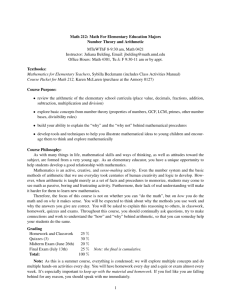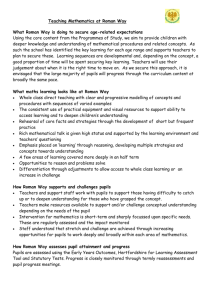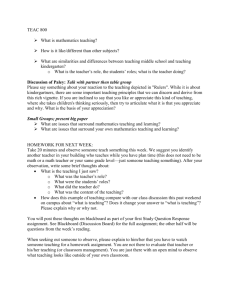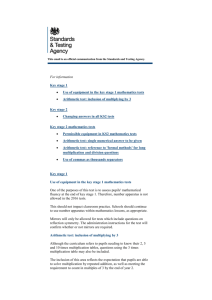Arithmetic Operations
advertisement
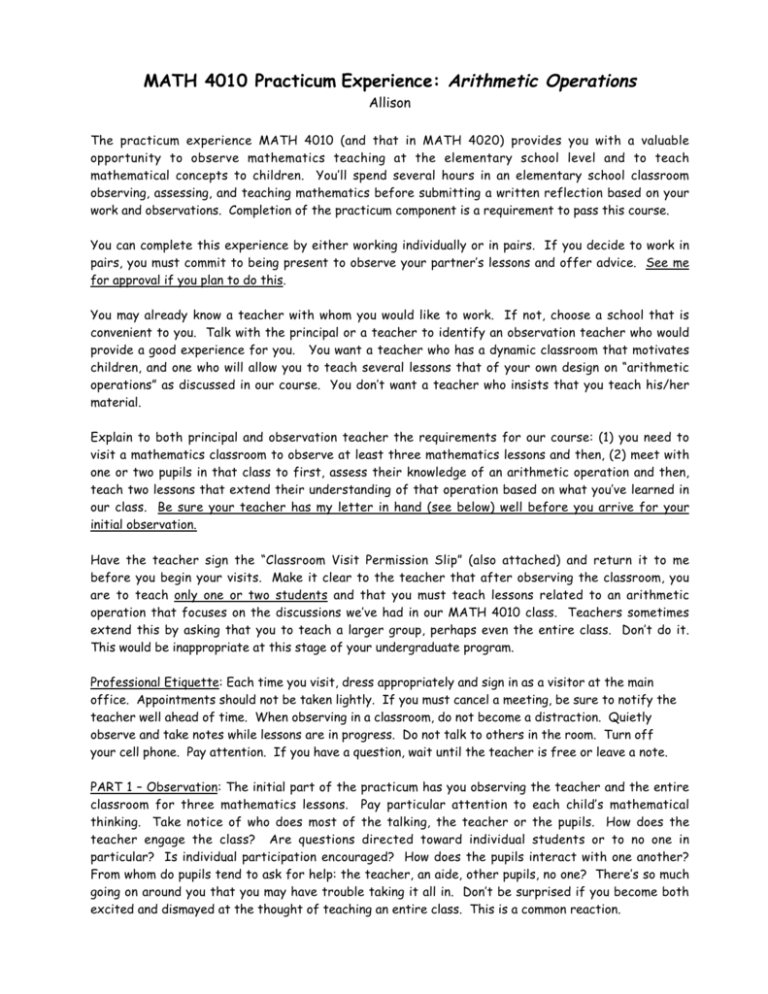
MATH 4010 Practicum Experience: Arithmetic Operations Allison The practicum experience MATH 4010 (and that in MATH 4020) provides you with a valuable opportunity to observe mathematics teaching at the elementary school level and to teach mathematical concepts to children. You’ll spend several hours in an elementary school classroom observing, assessing, and teaching mathematics before submitting a written reflection based on your work and observations. Completion of the practicum component is a requirement to pass this course. You can complete this experience by either working individually or in pairs. If you decide to work in pairs, you must commit to being present to observe your partner’s lessons and offer advice. See me for approval if you plan to do this. You may already know a teacher with whom you would like to work. If not, choose a school that is convenient to you. Talk with the principal or a teacher to identify an observation teacher who would provide a good experience for you. You want a teacher who has a dynamic classroom that motivates children, and one who will allow you to teach several lessons that of your own design on “arithmetic operations” as discussed in our course. You don’t want a teacher who insists that you teach his/her material. Explain to both principal and observation teacher the requirements for our course: (1) you need to visit a mathematics classroom to observe at least three mathematics lessons and then, (2) meet with one or two pupils in that class to first, assess their knowledge of an arithmetic operation and then, teach two lessons that extend their understanding of that operation based on what you’ve learned in our class. Be sure your teacher has my letter in hand (see below) well before you arrive for your initial observation. Have the teacher sign the “Classroom Visit Permission Slip” (also attached) and return it to me before you begin your visits. Make it clear to the teacher that after observing the classroom, you are to teach only one or two students and that you must teach lessons related to an arithmetic operation that focuses on the discussions we’ve had in our MATH 4010 class. Teachers sometimes extend this by asking that you to teach a larger group, perhaps even the entire class. Don’t do it. This would be inappropriate at this stage of your undergraduate program. Professional Etiquette: Each time you visit, dress appropriately and sign in as a visitor at the main office. Appointments should not be taken lightly. If you must cancel a meeting, be sure to notify the teacher well ahead of time. When observing in a classroom, do not become a distraction. Quietly observe and take notes while lessons are in progress. Do not talk to others in the room. Turn off your cell phone. Pay attention. If you have a question, wait until the teacher is free or leave a note. PART 1 – Observation: The initial part of the practicum has you observing the teacher and the entire classroom for three mathematics lessons. Pay particular attention to each child’s mathematical thinking. Take notice of who does most of the talking, the teacher or the pupils. How does the teacher engage the class? Are questions directed toward individual students or to no one in particular? Is individual participation encouraged? How does the pupils interact with one another? From whom do pupils tend to ask for help: the teacher, an aide, other pupils, no one? There’s so much going on around you that you may have trouble taking it all in. Don’t be surprised if you become both excited and dismayed at the thought of teaching an entire class. This is a common reaction. Take notes for later reference. Write down what you observe. Think about what you expected prior to your visit and what you’ve learned. Your notes and reflections will be of great help to you later when you prepare your written analysis in Part 3, or they may become the subject of later class discussions. See the semester schedule in your syllabus for a recommended date to complete Part 1. PART 2 - Teaching: This part of the practicum focuses on your work with one or two children in the same classroom that you have not known previously. Before proceeding, consult the State Core Mathematics Curriculum to review the arithmetic concepts for this grade level. Discuss with the teacher the topics you plan to cover. It will be important that you meet with the same pupil(s) each time to develop continuity and insight into the success of your efforts. Your first lesson with an individual student is actually an observation and assessment. As best you can, assess his/her understanding of arithmetic. For Grades K-2 have addition or subtraction in mind, as well as our classroom models for each and student familiarity with the four-family facts. What does the State Core Curriculum expect of students at this level? Can your student perform these operations adequately, and can they recognize when to apply each operation in story problems? For Grades 3-6, have multiplication or division with integers and operations with fractions in mind. Think about similar questions as stated above. For this initial assessment lesson, design a set of questions that will help you to discover what your student knows and doesn’t know. Probe the student’s responses to examine his/her reasoning. Think about the Marilyn Burns video we watched and how she probed the student’s understanding with deeper questioning and asking further questions that began “What if...?“. Can the student verbalize what he/she is doing, or does it appear his/her responses are purely memorized. Afterwards, reflect on what you have observed with this child and prepare a plan for how you hope to extend his/her understanding of some aspect of the arithmetic operations. You can’t accomplish much in a short time but plan to broaden you student’s understanding in some way. It’s the quality of your work and what you learn from this experience that is central goal here, not the quantity of material covered. Those of you working in pairs can intertwine your lessons by working together, but both should be present and participate for two observational assessments. After this, you’ll teach two lessons to your student. The classroom teacher may be able to help you plan your lessons (two each if working in pairs), but remember that you are not to teach additional material if requested by the teacher. Your lesson goals are to develop specific ideas regarding an arithmetic operation, not to teach unrelated mathematical material. For example if you teach a multidigit model for multiplication as we will be discussing in class, then in the next less plan to review and then teach something related to this, perhaps application in the form of story problems that require multi-digit multiplication or a more advanced multiplication model. Have a goal in mind for your lessons and keep in mind about how your lessons lead to your goal. I expect you to use the Curriculum Library to plan your lessons and select appropriate materials using the many elementary school textbooks on hand. Keep in mind that manipulatives are always helpful in presenting lessons. There should be evidence in your lessons that you have made use of ideas gleaned from our classroom discussions at some stage of your lessons. Again, see the schedule for a suggested date for completion of Part 2. PART 3 – Practicum Report: Your practicum experience concludes with a written reflection. This should be limited to no more than six typewritten pages, double-spaced, standard font, written on one side only. This paper summarizes your thoughts about your observations, the assessment activity, and your teaching component. Your written notes should be helpful here. It’s best to use an alias for your student’s name. This paper should not be a recounting of events regarding what happened ( ... she said ..., so I said ..., etc ... ), but a thoughtful reflection on what you’ve learned. The practicum report should include: (i) Include an initial summary that’s no more than one page. This should focus on the classroom: the grade level, class size, mathematical topics taught during observation, who did most of the talking, teaching methods observed (small- group activities, etc.), interest shown by pupils, etc. Also, were you working alone or with another student? (ii) Then, have summary of your expectations of your individual pupil’s knowledge of arithmetic prior to the assessment and the results of your initial evaluation based on comments/responses during your assessment phase (Lesson 1). How did the State Core shape your expectations? How did your assessment activities affect your choice of teaching topics and methods of presentation? (iii) Include brief summary or each of your lesson plans and your reflections on how the process developed. Did you involve the students to gain feedback? What surprises did you encounter? What were the primary difficulties that your pupil seemed to have? How did you respond? (iv) Finally, conclude with reflection on whether your student’s understanding seemed to change due to your efforts and why, or why you believe no change actually took place. How might the lessons have been improved if you could have done this again? It won’t be held against you if there were no changes. After all, this is something new to you and you’re working with a student you’ve never met. The grading rubric of this practicum report: (a) CLARITY: Is the paper written in complete sentences? Is there an opening paragraph to introduce this experience and a closing paragraph that summarizes your ideas? Are there grammatical errors so numerous as to interfere with or distract from my understanding of your analysis? Would a person only generally familiar with the practicum experience be able to understand you reflections? (b) DIRECTIONS: Have these directions been followed? Has enough thought been properly given to this reflection to make it a successful experience? Was too much time spent on superficial aspects of the lessons (conversation, etc) instead of describing your experience from a more thoughtful perspective? (c) ASSESSMENT: What evidence is there to indicate you made a reasonable attempt to assess pupil understanding of arithmetic operations? What conclusions did you draw? How did this affect your lessons? If working in pairs, how was the assessment conducted? (d) TEACHING: Did your lessons focus on an arithmetic operation? What goal s did you set for yourself? Did you promote pupil involvement in your lessons? Were the lessons related to one another as required and did they build toward this goal? What ideas from our class did you include? How did you incorporate materials from the Curriculum Library? (e) ANALYSIS: What evidence is there of a reasonable depth of analysis of your assessment and your teaching strands? How would you modify your assessment techniques, lesson plans, and/or teaching strategies if you could do this again? You are not expected to be totally successful in this teaching experiment. This is likely one of your first in-depth involvement in a teaching activity. What is important is that you make the attempt and show that you’ve reflected on the results of your efforts, so that you learn something new about teaching. Fall 2009 TO: RE: Classroom teachers and principals in Salt Lake City area schools Classroom visits by pre-service elementary-school teachers The student presenting this letter to you is enrolled in the elementary education program at the University of Utah and is currently taking MATH 4010. This program is based on and is consistent with the Standards 2000 published by the National Council of Teachers of Mathematics (NCTM). To provide a connection between the theory and practice of teaching mathematics, these students are required to spend time visiting mathematics classrooms, observing experienced teachers, and then focusing on one or two pupils. This assignment requires each student to observe an experienced teacher in the classroom for three mathematics lessons and then to meet with one or two students in that classroom to present short lessons on arithmetic. Lessons for Grades 1-2 explore pupil’s understanding of addition or subtraction. Those for Grades 3-6 focus on multiplication or division. The initial lesson involves an assessment of understanding of an arithmetic operation followed by two lessons that further this understanding of the operation. Our pre-service student is asked to take notes during both observation and teaching components that will be used for a paper to be submitted later. The paper will include : a. grade level, name of course, school, class size, etc. b. a characterization of the level of questions asked by teacher and pupils during observation c. a description and evaluation of the pre-service teacher’s assessment and teaching experiment Previous opportunities for our students to have practical experiences to observe and discuss mathematical topics with elementary school pupils have made a valuable contribution to their understanding of the need for precise development of lessons and effective communication of mathematical ideas. Our students improve their ability to respond to student questions based on different levels of comprehension. While these visits in no way replace the student-teaching experience to be undertaken later, this practicum is a helpful introduction to the classroom experience for prospective elementary school teachers. This letter should have been given to you well before the observation and teaching experience begins. Please know that I am grateful to those of you who are taking time to allow our students to visit your classes. This is a highly valued contribution to the professional development of the next generation of our schoolteachers. Sincerely, Dennis Allison Department of Mathematics Office: 581-5753, or 581-6851 (for messages) allison @math.utah.edu CLASSROOM VISIT PERMISSION SLIP (to be signed and returned): This student is presenting to you a letter from me explaining this request and asking for your approval. Your agreement to allow this student (or a pair of students) to visit you classroom and work with one or two pupils in your class should have a significant impact on our prospective elementary school teachers in their professional development. We greatly appreciate your willingness to provide time for this experience. Dennis Allison Instructor of mathematics for elementary school teachers The University of Utah 801-581-5753 allison@math.utah.edu I agree that _________________________________________ (student name) may visit my classroom to observe several lessons being taught on mathematics and then to conduct a series of teaching experiences with one or two students in my class at a mutually agreeable time. Name of Teacher/School: ________________________________ Name of Teacher: ________________________________ Phone number or e-mail: ________________________________ Thank you so much. Dennis Allison The University of Utah



